
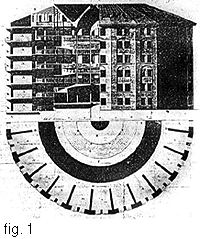

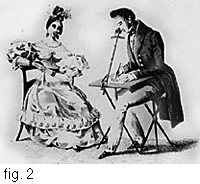

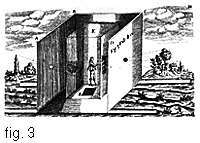

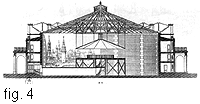

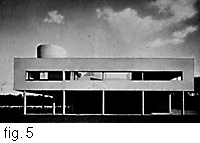

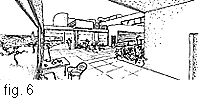

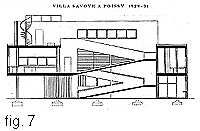

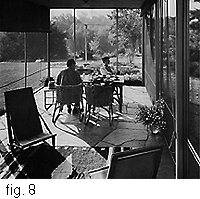

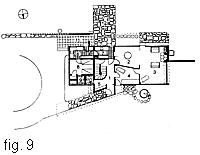

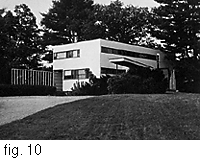
Gropius | Le Corbusier : The Two Faces of Modernism
The Gropius House in Lincoln (Massachusetts) designed by Walter Gropius in collaboration with Marcel Breuer in 1937 and the Villa Savoye at Poissy designed by Le Corbusier in 1929 and completed in 1931 are undoubtedly landmarks in the architectural history of this century. Although both architects' approach to design is placed within the general context of the Modern Movement their attitude towards the landscape in particular and the social context in general differs to such an extent that to term it as contrasting would not be an exaggeration.
The analysis of the design for the two houses mentioned above will help to expose the differences in attitude between these two architects and in extent to illuminate two different approaches to architectural design and its role within the social framework by architects included under the general umbrella of modernism. In order to understand the principles on which the Modern Movement was based one has to look as far back as the end of the 17th century, two hundred years before the foundations of modernism were laid.
As James Corner explains in his article "A Discourse on Theory I: 'Sounding the Depths' - Origins, Theory and Representation", artistic production before the Enlightenment was conceived as a figurative embodiment of divine order; through idealized mimesis "form, geometry, and pattern possessed a profound symbolic content" (p.64). During the late 17th and the early 18th centuries however, the scientific revolution brought an end to the metaphysical content of the traditional symbol systems of geometry and mathematics, turning them into purely formal practices. Thus, as knowledge was displaced from the world-as-lived to an autonomous status, a breach was created between human life and nature.
In addition to the promotion of science as an objective system divorced from cosmic order, the deterioration of the influence of religion and the dissolution of sacred values led to the end of mimesis, subsequently to production drained of divine content, and eventually to the separation of the object from the subject. As Habermas states, "the project of modernity formulated in the 18th century by the philosophers of the Enlightenment consisted in their efforts to develop objective science, universal morality and law, and autonomous art according to their inner logic" (As quoted in Corner, p.66).
The Enlightenment negated art and architecture that was based on the ambiguity and subjective nature of mimesis and intuition, and promoted work that was based on logical, clear and orderly principles. This insistence on clarity and order resulted in the gradual polarization of the different spheres of knowledge into entities divorced from public life. These autonomous spheres of knowledge found shelter in the newly founded academies and institutions within which the self-referentiality of the disciplines was nourished.
Michel Foucault has related the phenomenon of the academies of the Enlightenment with the model of the Panopticon. As he explains, the similarities lie in the fact that in both cases "knowledge became trapped within a spherical prison wall, easily surveilled and studied yet eternally confined" (As quoted in Corner, p.66). The architectural prototype of the Panopticon is emblematic of the ideals of the Enlightenment indeed, not only because it represents the self-refentiality and the entrapment of knowledge but also because it is organized by and for an orderly and logical system that promotes a perception of the world that is purely optical. For the Enlightenment brought about a taste for the Picturesque, which was in effect the consumption of landscape and the environment in general - be it natural or social - as an image. As James Corner states in the above-mentioned article, "the result was an aestheticised landscape where form and picture became the primary content and meaning" (p.71).
The Panopticon as developed by Jeremy Bentham in 1775 was made up of an observation tower placed in the center of a ring of cells that occupied its whole width. The cells were punctured on both sides so that the figures of the confined would be backlit and therefore easily discernible from the center. (fig.1) Thus architecture was for the first time in history consciously treated as a machine that would facilitate the exercise of power by the state and/or the ruling class over the masses.
The way that power was implemented within this architectural machine was through vision. The eye sufficed to surveil and control those confined in the perimeter, be they prisoners, pupils, lunatics or workers. Therefore the primacy of vision over the other senses was declared - a phenomenon that is widely agreed upon as one of the principal trademarks of modernity and which originated during the period of the Enlightenment.
Within the orderly space of the Panopticon, operated and controlled by the eye, a distinction between the overseer and the overseen was clearly defined. In this architectural model there is no seeing-being-seen dyad. The periphery is clearly the observed and the center the observer. Thus, the space of the Panopticon - like Modern space in general - becomes segmented, frozen, dead, and each individual is fixed in his place. Despite the presence of a privileged position, the central observation tower, all are trapped within this machine, doomed to immobility. As Foucault asserts in the "Eye of Power", the Panopticon is a machine within which everyone is caught, those who exercise power as much as those over whom power is exercise (p.49).
In this frozen space the perception of the privileged overseer (which is clearly the preferred location within this "en-lightened" space), differs fundamentally from that of the confined underprivileged mass. The centrally placed individual can only see the multitude of cells surrounding him and the flat outlines of the confined figures. Trapped as he is in the center of this spatial arrangement he has no way of looking at his tower from without or of understanding the spatial configuration of the machine that he inhabits. The experience of the overseer is strictly contemplative, for his position prevents him from comprehending the totality of the space that he occupies. His experience is abstract, his gaze comparable to that of the museum goer.
On the other hand, despite the underprivileged position of the confined pupil, prisoner, worker, or lunatic, he is able to see not only the tower placed in the center of their cells, but also at the cells opposite his and at the scape on the outside. By combining this series of images available to him the confined person is able to construct in his mind the totality of the scheme that he inhabits and to comprehend his own position within it.
Thus, one can maintain that the difference between the perception of the overseen and that of the overseer is that between pre-enlightenment and post-enlightenment, respectively. In the former case man was part of the world, comprehending and partaking in a collective existence, whereas in the latter case the individual becomes an alienated observer experiencing life merely as a flat surface, an image separated from him. Denis Cosgrove in his article "The Idea of Landscape" talked about this gap between the pre and the post Enlightenment aesthetic in regards to the landscape in particular. As he maintains, there is profound difference between the user of the land and the consumer of the landscape. This shift from use value to exchange value was a result of the Enlightenment for it was the beginning of a scientific, industrial, and social revolution that was the foundation of the new market economy which propelled the project of Modernism. As he specifically states, for the landowner land is "invested with a personal and social meaning that had little to do with its visual form. ... For the insider there is no clear separation of the self from the scene, subject from object. ... The insider does not enjoy the privilege of being able to walk away from the scene, as we can walk away from a framed picture or from a tourist viewpoint" (Cosgrove, p.19).
Hence, for the insider nature is a place which is unmediated by aesthetic conventions and where the individual harmoniously co-exists with the social. On the other hand, when the landscape is drawn, framed, and generally reproduced for consumption the viewer is in "critical respects removed from it" and therefore regards it as an object separated from his own subject (Cosgrove, p.18).
This difference between optical and haptic space can clearly be illustrated by two pre-photographic devices: the camera obscura and the camera lucida. The camera lucida was a device that enabled the user to draw an object by looking at it with one eye while keeping his other eye focused on the paper. (fig.2) Thus the artist at the same that he was transforming his environment into a two-dimensional representation to be consumed by the eye he was also aware of the world as a haptic space. He was part of a tactile world which could be experienced by moving through it, not merely by looking at it. His experience was a concrete one, his environment could be tactily appropriated and it contained himself and all that existed around him. The unity of the object and the subject was maintained and the individual co-existed with the social.
The experience of the user of the camera lucida is clearly comparable to that of the prisoner in the Panopticon, while the experience of the overseer placed in the central tower is analogous to that of the user of the camera obscura. (fig.3) This device was an enclosed dark room with a pinhole on one of its vertical sides permitting thus an image of the outside to be reflected on the inside. The user of the camera obscura - usually a painter or an engraver - was thus separated from his surroundings both physical and perceptually, experiencing the world as an image. His experience was solely optic and because of his physical separation from his environment he could not conceive of himself as part of a unified whole but instead he apprehended his entity as a centrally placed subject surrounded by the rest of the world. Like the overseer in the Panopticon he could not see himself in the context of all else and therefore while inside the camera obscura his was as abstract and alienated as the images reflected on the walls.
The development of the pre-photographic devices mentioned above was driven by the same "enlightened" obsession with the search for objective truth and the desire to impose order and regularity that gave birth to Bentham's Panopticon. The ultimate victory of the bourgeoisie - the "en-lightened" new class - was the invention of photography which made possible the production of an abundance of images that would come to govern social relations and hence transform concrete perception to mere contemplation. (Photography as we know it today is a development of the camera obscura and not of the camera lucida, the latter being genealogically closer to cinema.)
During the same period that the first experiments with photography were taking place, Panoramas started to appear in the urban centers of Europe. (fig.4) The Panoramas were cylindrical structures the interior surface of which was covered with uninterrupted landscape or city vistas. In order to access the panoramas one followed a sequence from the street entrance through a dark passage in order to find himself on a centrally placed platform within the structure from where he could look at the artificial vista. Once again we see the promotion of the perception favored by the philosophers of the Enlightenment: the individual separated from his surroundings, an alienated observer in search of objective truth.
Not only is the spatial configuration of the Panorama strikingly similar to the Panopticon but the experience of space that these devices foster is virtually identical. In both cases the middle ground is eliminated so that there is a clear division between the center and the periphery and as a consequence a separation between object and subject. But as the classical unity between the subject and the object is lost both become so abstract that they are subsequently reunited on the basis of their mutual abstraction. As Henri Lefevbre states in "The Production of Space", modern space is "shattered into images, into signs, into connected-yet-disconnected data directed at a 'subject' itself doomed to abstraction" (p.313). The "abstract subject" uses only the eye to read the codes of his surroundings and to move through its visual field. Thus the reality that was previously concrete, tactily appropriated, is now a surface that contains everything and is contained by everything and it is onto this surface that the object and the subject are collapsed.
The Panopticon and the Panorama were the birthplaces of the space of modernity about which Guy Debord wrote in his situationist manifesto "The Society of the Spectacle". Debord asserts that modern space is governed by the spectacle as a social relationship; all that used to be directly lived now becomes mere representation. Images merge into a "common stream" impairing irrevocably the unity of life and the tactility of experience. According to Debord, reality is apprehended in a "partial way, and it unfolds in a new generality as a pseudo-world apart solely as an object of contemplation" (p.12).
And indeed the landscape around Corbusier's Villa Savoye is undoubtedly an object of contemplation. The villa is basically a box which hovers over the orchard that surrounds it, clearly stating its presence as an object from which the occupant can look at nature as an image on display. The ground floor of the villa is recessed on three sides creating a dark cavity that not only provides for the illusion of the house as a hovering box but which also hides its entrance, delivering thus a reinforced message of detachment and inaccessibility. (fig.5) Approached from the driveway that leads to the recessed garage, the Villa declares its own objecthood, leaving no doubt about its separation from its context both physical and social.
As in the case of the Panorama one has to traverse a dark space in order to enter an interior which is essentially a viewing platform. The first, and main, floor of the Villa is surrounded with a band of windows which frames the surrounding nature like a picture in a museum. Like the Panorama, the middle ground between the individual and nature is elliminated altogether, separating object from subject. Like the consumer of the landscape, the outsider, that Cosgrove talked about in the "Idea of Landscape", the individual once inside the Villa can choose to consume the images of nature or he can choose to turn away for the unity between the two is obliterated.
Once the inhabitant or the visitor to the Villa crosses the dark threshold of the entrance and ascends to the first floor he is immediately transformed into a subject who is divorced from the land and who is only able to look at his surroundings in a detached, "enlightened" way. This is made especially apparent by Le Corbusier in one of his drawings which shows an oblique view from the verandah. The frame-window is clearly a divider, a barrier between a removed subject and an abstract, an aestheticised landscape. (fig.6)
The perception of the individual inside the Villa is virtually the same as that of the overseer in the central observation tower of the Panopticon. Once inside the Villa he can only look out from his box, but he is not able to see or understand his position within nature, his perception is solely contemplative and therefore abstract. This lack of a tactile experience is repeated within the walls of the Villa. The interior is organized around a ramp, offering architecture merely as a series of images to the individual who traverses the space. (fig.7) Because it seizes to be a tactile place where the subject and the object are one, the Villa is like a Picturesque garden. The individual never feels at home here, but he wanders endlessly through the spaces consuming the images of the "promenade architectural". This is not a place that can be concretely experienced but an abstract object-space inhabited by an abstract subject. What Colin Rowe observes in an essay titled "The Mathematics of the Ideal Villa" about Corbusier's villa at Garches is equally true for the villa at Poissy:
It is an interior which seems to be regulated by the intellect only, operating as it were inside a stage vacuum. ... To the intellect it is clear to the senses deeply perplexing; and it seems not to be possible to stand anywhere in it, at any one point in it and receive a palpable impression of the whole. ... At Garches the central focus has been consistently broken up, concentration at one point is disintegrated, and replaced by a peripheral dispersion of incident. The dismembered fragments of the central focus become, in fact, a sort of serial installation of interest round the extremities of the plan. (Le Corbusier in Perspective, p.52)
The Villa is a true child of the Enlightenment. Like the 18th century philosophers who called for order and who searched for universal laws to govern art and architecture so did Le Corbusier seek to penetrate the essentials of nature and to extract an ideal and universal form that would be his template. As Paul Westheim states in the essay "Architecture in France: Le Corbusier-Saugnier", Le Corbusier "wants the shaped form, wants the same things as the cubist painter, who relies upon esprit, logic, and adherence to the laws of mathematics: the grand harmony of elementary values of form (p.31). But form in this case is no longer an embodiment of divine order, it is autonomous and organized according to a self-referential geometric system.
Le Corbusier goes as far in his pursuit of aestheticised form as to place the garden on the roof. Here the natural world is as conceptually removed from the land as it is physically separated from it. The planters are organized according to the autonomous geometric order that governs the rest of the house. Le Corbusier pointed out that the roof garden is a place "far from the street where one can experience a feeling of security and well-being" (Badovici p.13). Thus, by eliminating any sort of ambiguity or subjectivity, he turns nature into a commodity that is "safe" for consumption by the alienated and abstract modern subject.
Walter Gropius's house for his family exhibits a wholly different attitude towards nature and hence towards public life in general. The photograph of himself and his wife in the screened porch at the rear of the house reveals the proximity - physical and perceptual - of the architecture to nature. (fig.8) In this case nature penetrates the architecture and vice versa. Although the house is, like Villa Savoye, organized around the staircase which leads to the second floor, it is not in this case a container. Instead the rooms gradually disintegrate in order to merge with nature; spaces stretch until they become stone walls or trellises that extend out like arms to embrace the natural surroundings (fig.9). The entrance pushes forward at an angle, like a branch of a tree, to invite and lead the visitor to its interior. (fig.10)
The house does not separate the inhabitant from nature but instead it is continually reinforcing his connection to the land. The subject in this case is not divorced from the object, the self is not separated from the scene, but they co-exist in the public and social realm. As Nancy Curtis writes in the catalogue published by the Society for the Preservation of New England Antiquities, Gropius's design displays a "unity of thought that sees each object in relation to each other and to the whole" (p. 14). This is not an observation platform like a Panorama or like the autonomous observation tower of the Panopticon, one is able to understand himself as part of the surroundings. Seating in the screened porch or on the second floor balcony one is simultaneously inside and outside and therefore he regards his surroundings as a continuum of which he is a part as well.
Gropius did not disregard the context, the community, and the environment in favor of the individual object, but he adopted an all-embracing attitude toward design. He studied and selected to use a vocabulary of typical New England materials and forms and then he created a space that is akin to the perception of the world which preceded the Enlightenment. The house is undoubtedly modern in its use of mass produced materials, and in its economy of form, but unlike Corbusier's design, the form is not the content here. The geometry is enlivened with strategically placed curves and diagonals that break away from a rigid geometrical system that would otherwise result in a pristine white box. The house starts to become a figurative embodiment of nature; Gropius is not afraid of making something beautiful guided by his intuition. As Nancy Curtis points out, "the house that is supposed to express reason in pure form has turned out to personify poetry as well." (p.13).
Through the analysis of these two houses it has become apparent that what is often generalized as modern architecture can be very different in concept. Modernism does not have to mean an alienation from one's context, a reinforcement of the abstractness of existence that was initiated by the ideals of the Enlightenment. Gropius has shown us that there is a way to keep up with advances in technology but without sacrificing the possibility for a concrete and tactile experience.
© pavlina lucas 1999
